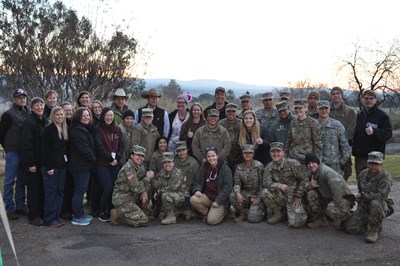VET, AgriLife Return Home From First Out-Of-State Deployment

After almost a month in Butte County, California, members of the Texas A&M Veterinary Emergency Team (VET) and AgriLife Extension Service are beginning their journey home today.
During the 29-day deployment, the team’s first outside of Texas, 12 members of the VET and seven AgriLife Extension agents from across Texas worked at the Del Oro Emergency Animal Shelter in Oroville, California, aiding with volunteer, inventory, and data management, as well as medical care to the many animals sheltered there.
While the conditions were cold and rainy, often accompanied by high wind speeds (and one day, a tornado warning!), VET members and AgriLife Extension agents stayed busy, working with the Butte County Incident Command, California National Guard, San Jose Conservation Corps, and North Valley Animal Disaster Group at the shelter and providing oversight in the efforts to return sheltered pets to their owners, reunite those that were lost or missing with their owners, and send unclaimed animals to area shelters as those shelters had space open up and were again able to accommodate more pets.
“This was such a different deployment. We came in late rather than early and arrived to find a difficult situation,” said Dr. Wesley Bissett, VET director and associate professor in the Texas A&M College of Veterinary Medicine & Biomedical Sciences (CVM).
“Butte County was faced with an overwhelming incident that was 10 times larger than anything they had ever faced,” he said. “Imagine towns the size of perhaps Bastrop that had been basically destroyed. This was worse (than the 2011 Bastrop County wildfire) from the perspective of the number of homes destroyed, lives lost, and complete destruction of a town.”
Bissett said the arrival of the VET came when the emergency shelter needed it most.
“The magnitude of this disaster required response resources from local, state, and federal levels of government,” he said. “Our first task at the shelter was to work with everyone so that we were all on the same page. A large part of this was gaining this community’s trust. This was accomplished and we moved on to getting the medical situations stabilized, the logistics aspect organized, data management reconciled, and the overall situation improved for responder and animal. These changes were striking and occurred rapidly thanks to the hard work of all involved. This was truly a community effort that extended from Butte County Animal Control leadership down to each of the units involved in this response.
“The days were long and the weather was at its worst, but it all paid off in terms of smiles, new relationships, and happier, healthier animals,” he said.
In working to spread the Aggie Spirit, team members were struck and humbled by the outpouring of love and support witnessed among members of the National Guard and the volunteers serving at the shelter site, many of whom are victims of the Camp Fire, themselves; on top of that, these were people facing almost complete destruction of Paradise. The stories team members heard from victims and the destruction witnessed as a result of the fire will be one that the Texas A&M contingent will never forget.
“This has been an amazing deployment that has really showcased the capabilities of the VET and AgriLife Extension,” Bissett said. “I think more importantly, it has showcased just how powerful it is for us to work closely together.”
As team members prepared to depart, Bissett said he also was struck by the role Texas A&M and the Texas A&M University’s System’s plays in these kinds of situations; in addition to the VET and the AgriLife Extension Service, Texas Task Force 1 and the Forest Service also responded to the Camp Fire. But goodbyes, he said, are never easy.
“Our final departure will be tough. We have been here a long time and have developed such good friendships with everyone—the bonds we develop with a community that we respond to is always incredibly strong,” he said. “I suspect that there will be tears all around, but it will be time for us to go. As close as we have all become, they cannot recover until we leave. As ready as I am to come home, these will be tough goodbyes.”
###
For more information about the Texas A&M College of Veterinary Medicine & Biomedical Sciences, please visit our website at vetmed.tamu.edu or join us on Facebook, Instagram, and Twitter.
Contact Information: Megan Palsa, Executive Director of Communications, Media & Public Relations, Texas A&M College of Veterinary Medicine & Biomedical Science; mpalsa@cvm.tamu.edu; 979-862-4216; 979-421-3121 (cell)


